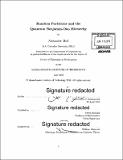| dc.contributor.advisor | Alexei Borodin. | en_US |
| dc.contributor.author | Moll, Alexander (Alexander Christian Vincent) | en_US |
| dc.contributor.other | Massachusetts Institute of Technology. Department of Mathematics. | en_US |
| dc.date.accessioned | 2016-09-30T19:36:48Z | |
| dc.date.available | 2016-09-30T19:36:48Z | |
| dc.date.copyright | 2016 | en_US |
| dc.date.issued | 2016 | en_US |
| dc.identifier.uri | http://hdl.handle.net/1721.1/104582 | |
| dc.description | Thesis: Ph. D., Massachusetts Institute of Technology, Department of Mathematics, 2016. | en_US |
| dc.description | Cataloged from PDF version of thesis. | en_US |
| dc.description | Includes bibliographical references (pages 74-78). | en_US |
| dc.description.abstract | Stanley's Cauchy identity for Jack symmetric functions defines a Jack measure, a model random partitions for every analytic real function v(w) on the unit circle and parameters E2 < 0 < E1. Jacks are eigenfunctions of the Hamiltonian ... of the quantum Benjamin-Ono equation with periodic boundary conditions, dispersion and quantization corresponding E1 + E2 and -E1E2 respectively. From this point of view, Jack measures are the random energy distribution of a coherent state around a classical configuration v(w). Taking E2 --> 0 <-- E1 at a comparable rate [beta]/2, we prove that the slopes of the profiles of the random partition concentrate on a limit shape independent of [beta], the push-forward of the uniform measure on the circle along v. This is the conserved density of the classical inviscid Hopf hierarchy on the circle, following Dubrovin (2014). At the quantum Hopf hierarchy ([beta] = 2), we recover Okounkov's limit shape for Schur measures (2003) as a verification of the correspondence principle. Our main result is the computation of macroscopic fluctuations of random profiles around the limit shape: they converge to the push-forward along v of the restriction to the circle of a Gaussian free field on the upper half-plane whose covariance is independent of [beta]. At [beta] = 2, our result matches Breuer-Duits' central limit theorem (2013) for Borodin's biorthogonal ensembles. Our limit theorems follow from a diagrammatic all-order convergent expansion of joint cumulants of linear statistics over "ribbon paths". This expansion has the same form as the 1/N refined topological asymptotic expansion over ribbon graphs on surfaces for [beta]-ensembles on the line in one-cut potentials V due to Chekhov-Eynard (2006) and Borot-Guionnet (2012). Our analysis relies on the Lax operator L for the quantum Benjamin-Ono hierarchy introduced by Nazarov-Sklyanin (2013). L is expressed through Toeplitz operators whose symbols are affine Kac-Moody currents for gl1. We use the spectral shift function of L to construct a generating function y(u) of local Hamiltonians commuting with y3. This explicit y(u) is a special case of the y-operator defined implicitly by functional calculus in Nekrasov (2016). | en_US |
| dc.description.statementofresponsibility | by Alexander Moll. | en_US |
| dc.format.extent | 78 pages | en_US |
| dc.language.iso | eng | en_US |
| dc.publisher | Massachusetts Institute of Technology | en_US |
| dc.rights | M.I.T. theses are protected by copyright. They may be viewed from this source for any purpose, but reproduction or distribution in any format is prohibited without written permission. See provided URL for inquiries about permission. | en_US |
| dc.rights.uri | http://dspace.mit.edu/handle/1721.1/7582 | en_US |
| dc.subject | Mathematics. | en_US |
| dc.title | Random partitions and the quantum Benjamin-Ono hierarchy | en_US |
| dc.type | Thesis | en_US |
| dc.description.degree | Ph. D. | en_US |
| dc.contributor.department | Massachusetts Institute of Technology. Department of Mathematics | |
| dc.identifier.oclc | 958710849 | en_US |
